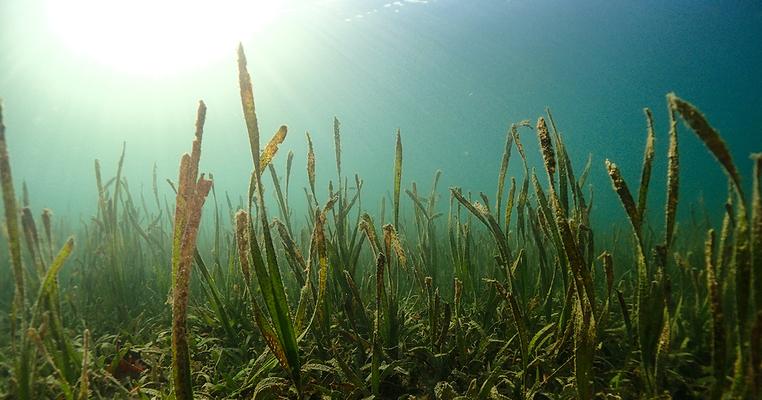
The Solutions Right in Front of Us: Seagrass
Did you know that “under the sea / under the sea / down where it’s wetter” there is a nearly invisible ecosystem that spans the ocean floor from Greenland to New Guinea?
Now, this ecosystem isn’t literally invisible, not by any stretch of the imagination. But figuratively … let’s just say it isn’t thought of often by many.
What is this ecosystem, you may ask? Well, it’s none other than vast, rolling “fields” of seagrass, of course – and it could be a big help in the fight against climate change (if we let it).
What is Seagrass?
Let’s start with what seagrass isn’t: seagrass is not seaweed.
Seagrass is more like a palm or a lily and grows at depths of three to nine feet in salt water. You may be asking, “How does a plant grow under water?” Well, that’s simple enough too: Seagrass grows both vertically and horizontality, and captures sunlight and nutrients from the water around it and the sediment below it.
“Seagrasses are the forgotten ecosystem,” according to Ronald Jumeau, a United Nations representative from the Republic of Seychelles. “Swaying gently beneath the surface of the ocean, seagrasses are too often out of sight and out of mind, overshadowed by colorful coral reefs and mighty mangroves.”
But, he adds, “[They] are among the most productive natural habitats on land or sea.”
As efforts to tackle the climate crisis become ever-more urgent, finding new ways to ratchet down emissions are becoming more and more critical. Luckily, our maritime ecosystems are rife with untapped carbon sequestration – and impact mitigation – potential.
Seagrass Is Under Threat
Seagrass meadows are among the world's most threatened ecosystems, and they are rapidly disappearing in many places. Over a third have been lost in just the past 40 years.
Seagrass has been declining globally at a rate of about 7 percent per year. That is the equivalent to a football field of seagrass lost every 30 minutes.
That is roughly 17,520 football fields lost a year – and it’s not as if they are disappearing quietly. All those football fields of seagrass gave up about the equivalent of 330 million metric tons of carbon emissions (again, annually) — like adding 71 million cars to the road a year.
“The impact of the one billion or more people who live within 50 km of [seagrasses] is largely the cause, including damage from coastal development and degraded water quality from nutrient pollution. Annual rates of decline have accelerated, with loss rates comparable to those of coral reefs and tropical rainforests.” says UNEP marine ecosystems expert Gabriel Grimsditch.
Development of our coastlines and pollution of the sea are main culprits. Increased runoff from land carries sediment that clouds the water, blocking sunlight from the seagrass. Runoff can also carry contaminants and nutrients from fertilizers that disrupt habitats, cause algal blooms, and kill aquatic plant life.
"It is not that we can blame one person, industry, or organization, it's the growth of a population around the coast," Dr. Richard Unsworth of Swansea University said.
Huge Solution Potential
A report from the Intergovernmental Panel on Climate Change (IPCC) focusing on oceans points out that mangroves, salt marshes, and seagrass meadows can store up to 1,000 tons of carbon per hectare — much higher than most terrestrial ecosystems.
Renewables and cutting carbon are what are going to get us where we need to go, but we also need to pull carbon from our atmosphere to limit the worst of current global warming and climate change. And seagrasses have the potential to be an especially effective "secret weapon in the fight against global heating."
By re-establishing these underwater meadows, we can greatly increase the carbon storage potential of our oceans:
- Seagrass accounts for 10 percent of the ocean’s capacity to store carbon despite occupying only 0.2 percent of the sea floor.
- Seagrass can capture carbon from the atmosphere up to 35 times faster than tropical rainforests
- Fifty to 90 percent of the carbon captured is stored in underwater soils.
- Fully restored seagrass beds have the potential to mitigate up to 700 million metric tons CO2e, equivalent to removing up to 151 million cars off the road for one year.
“We see seagrass as this wonder plant because of its ability to fight climate change, to help fish stocks, coastal communities and livelihoods,” the World Wildlife Fund told the BBC. “We need to expand hundreds of thousands of hectares of seagrasses, saltmarshes, and other coastal ecosystems to avoid some of the damages from climate change."
Vital For A Healthy Ocean
As well as creating vital carbon sinks, seagrass beds help create healthier oceans overall.
Seagrasses can:
- Provide habitats for fish, sea horses, crustaceans and others; food for sea turtles, waterfowl, and other marine mammals; and nurseries for an astounding 20 percent of the largest fisheries on the planet.
- Slow currents and protect beaches from coastal erosion, waves, and even climate change-exacerbated storms.
- Produce oxygen and clean the water by absorbing polluting nutrients.
What Can You Do
To beat the climate crisis, we have to do all we can.
On the long to-do list of climate musts, restoring seagrass habitats may not even register alongside stopping the construction of new natural gas power plants or fighting to bring wind or solar energy to your town.
But every little bit helps. Every difference you make ripples around the world. And to achieve the fair, just, and sustainable future we all deserve, we have to change everything.

